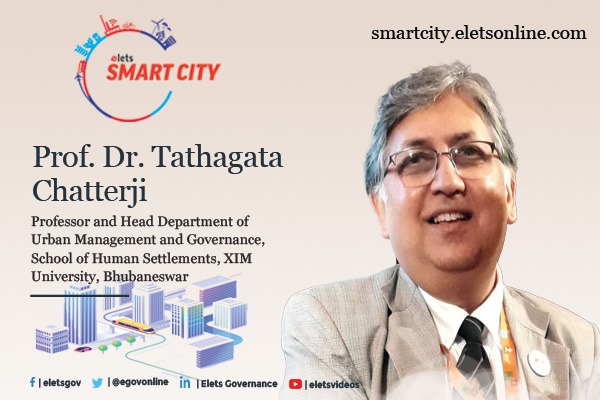
Urbanisation and digitalisation are two megatrends that define 21st-century India. It is imperative to bring greater synergy between the two forces to boost economic growth, generate jobs, achieve sustainable development goals, reduce vulnerabilities against climate change and other disaster threats, and improve the quality of life for the people.
India is going through a momentous urban shift and is well on its way to becoming an urban-majority country by the centenary year of its independence. Between 2022 and 2047, over 329 million people will be added to urban India, according to UN projections¹. The challenge is how to manage this urban transition in a green and sustainable way. Otherwise, traffic gridlocks, air pollution, water scarcity, and other negative externalities associated with urbanisation could negate the projected gains.
Digitalisation can help address many of these challenges. Connecting sensors and data to a city’s infrastructure networks can improve operational efficiency, reduce wastage, and boost environmental performance.
India is a global digital economy powerhouse. The ICT segment has long been the key driver of the Indian economy and forex earner. In recent years, there has been a tremendous upswing in domestic demand.
Technology aggregators are changing the way people eat, travel, and shop. In parallel, application platforms like Aadhar, Cowin, and Arogya Sethu are rewriting how governments and citizens connect with each other.
Digital technology applications in urban management received a significant push with the launch of the Smart Cities Mission² and the establishment of the Integrated Command and Control Centre (ICCC) in all 100 cities.
The Integrated Command and Control Centres ( ICCCs) are the nerve centres of urban management in smart cities. By aggregating data from IoT-based sensors spread across the city into actionable information using visualisation tools like GIS, they facilitate inter-departmental coordination and fast-track civic operations. During the COVID-19 pandemic, many cities turned their ICCCs into war rooms³ to deliver a wide range of functions, from tracking hospital bed availability to delivering medicine to needy persons.
The functioning of Indian cities has long been hindered by the lack of reliable city-level data, leading to a lack of up-to-date information on critical issues. Furthermore, it is challenging to aggregate data as different agencies hold information on various aspects such as health, crime, mobility, and pollution. In 2018, the Smart Cities Mission launched the Data Smart Cities Strategy⁴ to address this gap and promote a more data-driven and integrated approach to urban management.
The Data Smart strategy mandates each smart city to establish its own City Data Policy and appoint a City Data Officer as the institutional anchor to implement the policy. With its three guiding pillars of ‘People – Platform- Process’⁵, City Data Policies⁶ are required to:
(a) develop institutional capacities in data management and allocate specific budgets for data- related expenditures.
(b) facilitate collaborations between state and non-state actors for data sharing, and
(c) establish protocols for data security and usage.
The Data Maturity Assessment Framework (Cycle – 2)⁷ conducted in June 2021 evaluated the data readiness of 100 Smart Cities, indicating a significant challenge ahead. The framework ranked all 100 cities on a scale of 0-100. Only four cities (Surat, Pimpri-Chinchwad, Bhopal, and Pune) scored over 75 and were classified as ‘connected’. Eight cities were categorised as ‘enabled’, followed by 11 cities as ‘explorers’ and 19 cities as ‘initiators’. However, 58 cities are still at the ‘beginner’ level, scoring below the national average of 32. Nevertheless, progress has been initiated.
Also Read | Towards Sustainable Growth in a World of Irreversible Urbanisation
Another major step towards digitalization is the launch of the National Urban Digital Mission⁸ in 2021. This mission has brought together various urban-centric data platforms, broadly grouped into three areas: city performance monitoring, exchange of information between data producers and consumers, and capacity-building training for city officials.
Data readiness and digitalization, however, are not the end goals but rather means to improve environmental outcomes and reduce disaster risks. At the UN’s COP26⁹, summit on climate change, India pledged to achieve carbon neutrality and become net zero by 2070, with smart cities playing a central role. It is crucial to measure the performance of smart cities in terms of tangible improvements in pollution control, biodiversity conservation, renewable energy usage, waste recycling, and other critical environmental parameters. The Climate Smart Cities Framework¹⁰ developed by the National Institute of Urban Affairs can serve as a valuable template towards this objective.
Indeed, the Data Smart Cities Strategy, the National Urban Digital Mission, and the Climate Smart Cities Framework are the three most significant elements that can drive Indian Smart Cities towards a greener future.
Views expressed by- Prof. Dr. Tathagata Chatterji, Professor and Head Department of Urban Management and Governance, School of Human Settlements, XIM University, Bhubaneswar
References:
1. https://population.un.org/wup/
2. https://smartcities.gov.in/
3. https://www.weforum.org/ agenda/2020/12/indian-smart-cities-offer- a-model-for-pandemic-recovery/
4. https://dsc.smartcities.gov.in/
5. https://dsc.smartcities.gov.in/
6. https://dmaf.mohua.gov.in/
7. https://nudm.mohua.gov.in/about/
8. https://nudm.mohua.gov.in/platforms/
9. https://www.un.org/en/climatechange/cop26
10. https://smartcities.gov.in/climatesmart_
cities





















